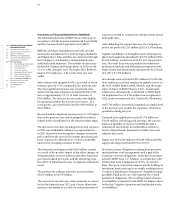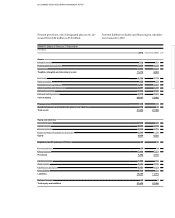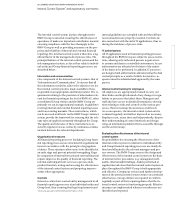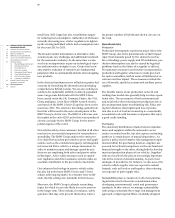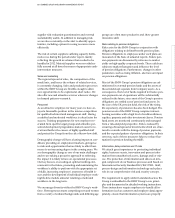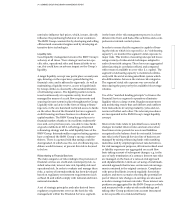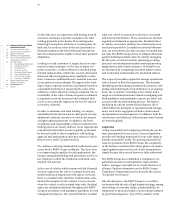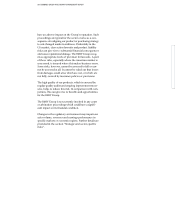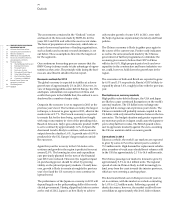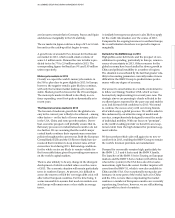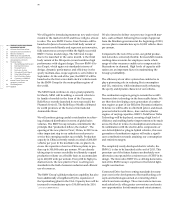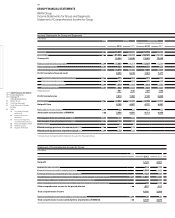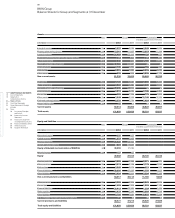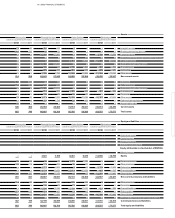BMW 2012 Annual Report Download - page 72
Download and view the complete annual report
Please find page 72 of the 2012 BMW annual report below. You can navigate through the pages in the report by either clicking on the pages listed below, or by using the keyword search tool below to find specific information within the annual report.
72
18 COMBINED GROUP AND COMPANY
MANAGEMENT REPORT
18 A Review of the Financial Year
21 General Economic Environment
24 Review of Operations
44 BMW Stock and Capital Market
47 Disclosures relevant for takeovers
and explanatory comments
50 Financial Analysis
50 Internal Management System
52 Earnings Performance
54 Financial Position
57 Net Assets Position
59 Subsequent Events Report
59 Value Added Statement
61 Key Performance Figures
62 Comments on BMW AG
65 Internal Control System and
explanatory comments
66 Risk Management
74 Outlook
Credit risks arise in conjunction with lending to retail
customers and major corporate customers, the latter
relating primarily to the dealer, fleet and importer
financing / leasing lines of business. Counterparty de-
fault risk, by contrast, refers to the risk that banks or
financial institutes with which financial instruments
have been transacted are unable to meet their payment
obligations.
Lending to retail customers is largely based on auto-
mated scoring techniques. In the case of major cor-
porate customers, creditworthiness is checked using
internal rating models, which take account of financial
statement data and supplementary qualitative evalua-
tions. Customer creditworthiness is tested at least once
a year and revised accordingly. The approval for lend-
ing to major corporate customers is primarily based on
a standardised method of measuring the value of the
vehicle(s) or other object(s) serving as collateral. The re-
coverability of the value of items accepted as collateral
is regularly reviewed, measured and evaluated with
a view to assessing the impact on the level of risk not
covered by collateral.
In order to minimise risk from lending, we employ
standardised instruments such as subsequent security,
additional collateral, retention of vehicle documents
or
higher upfront payments. In addition, the levels
of authority and responsibility of those involved in the
lending process are clearly defined. Local, regional and
centralised credit audits are also regularly performed
by Internal Audit to check compliance with lending
approval and authorisation rules procedures as well as
the processes and IT systems involved.
We continue to develop standardised credit decision pro-
cesses
for the BMW Group worldwide. The focus here
is
on improving the quality of credit applications, the
Group’s rating methodology and procedures used to se-
lect employees within the worldwide credit and coun-
terparty risk network.
In the case of vehicles which remain with the Financial
Services segment at the end of a contract (leases and
credit financing arrangements with option of return),
there is a residual value risk if the residual value calcu-
lated at the inception of the contract is not recovered
when the vehicle is sold (residual value risk). Residual
values are calculated uniformly throughout the BMW
Group in accordance with mandatory guidelines. For risk
management purposes, the expected risk-free residual
value of a vehicle is measured on the basis of external
and internal information. These amounts are checked
regularly and adjusted as appropriate. Residual values
of vehicles on used car markets are continuously moni-
tored and reported on. In addition to internal informa-
tion, our assessments also take account of external mar-
ket data. The BMW Group strives to mitigate effectively
against declining residual values by actively managing
the life cycles of current models, optimising reselling
processes on international markets and implementing
targeted price and volume measures. Potential losses
are measured by comparing forecasted market values
and contractual residual values by model and market.
The scope of procedures applied to manage operational
risks is based on Basel II requirements. This includes
identifying and measuring potential risk scenarios, com-
puting
and monitoring key risk indicators on an ongoing
basis, the systematic recording of loss claims and a
range of coordinated measures aimed at mitigating risk.
Both qualitative and quantitative aspects are taken into
account in the decision-making process. The latter is
backed up by various system-based solutions, all of
which follow the principles of operational risk manage-
ment, such as the segregation of duties, dual control,
documentation and transparency. In addition, both the
effectiveness and efficiency of the internal control system
are tested regularly.
Legal risks
Acting responsibly and complying with the law are the
basic prerequisites for our success. Current legislation
provides the binding framework for our wide range of
activities around the world. The growing international
scale of operations of the BMW Group, the complexity
of the business world and the whole gamut of complex
legal regulations increase the risk of laws being broken,
simply because they are not known or fully understood.
The BMW Group has established a Compliance Or-
ganisation
aimed at ensuring that its representative
bodies, managers and staff act in a lawful manner at
all
times. Further information on the BMW Group’s
Compliance Organisation can be found in the section
“Corporate Governance”.
Like all enterprises, the BMW Group is, or could be,
confronted with the risk of legal disputes relating, among
other things, to warranty claims, product liability,
in-
fringement of protected rights or proceedings initiated
by government agencies. Any of these matters could


